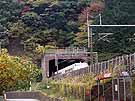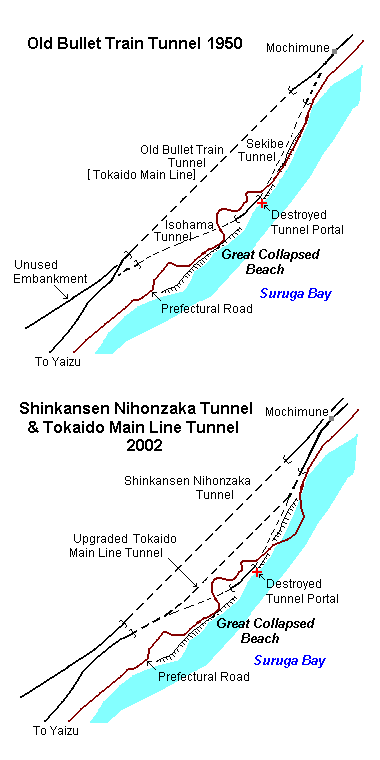
An east-bound 300 series bullet train entering Nihonzaka Tunnel. The tunnel shows no evidence that this is in fact an old bullet train tunnel dug before World War II.
 |
|
An east-bound 300 series bullet train entering Nihonzaka Tunnel. The tunnel shows no evidence that this is in fact an old bullet train tunnel dug before World War II. |
'The real bullet train' by Dr Christopher P. Hood in Bullet-in #43
really recalled one of my old memories. The memory dates back to the
late 50s through the early 60s when I was a child. As Dr Hood wrote,
before the War, due to the establishment of the bullet train plan,
about around 20 % of the land required for the planned route was
acquired, and work to construct two tunnels even began. One of them is
the famous, long New-Tanna tunnel, which was partially dug, and the
other was a tunnel, named Nihonzaka Tunnel, located between Mochimune
and Yaizu on the Tokaido Main Line in Shizuoka prefecture, which was
thoroughly completed. When you travel down on a Shinkansen train, after
leaving Shizuoka, crossing a fairly long bridge over the Abe River, a
mountain range comes closer to you from the northwest. Soon, your train
runs into a thick flank of the mountain that reaches down as far as the
sea blocking your way, but your train goes straight through a tunnel
penetrating the flank. This is the oldest tunnel over the entire
Shinkansen route that was dug before and during the War. Actually, I
used to go through this tunnel many times when I was a child more than
40 years ago, on an electric loco-hauled train, without any knowledge
of the old bullet train. Yes, the tunnel was put in use for the Tokaido
Main Line after the War, changing the route from the old tunnel that
took a coastal route that is only just over one hounded meters away.
In my boyhood days, I was living in Shizuoka city. Since my parents
both were from the western part of the prefecture, we had many
relatives around the Hamamatsu area. Visiting the relatives during
school holidays to Hamamatsu and as far as Bentenjima (Benten Island on
Hamana Lake) was a great pleasure for me, because I was able to ride a
train over a long distance. It was only an about a 90 km trip with a
ride of about 2 and half hours, but enjoyable enough for a kid raised
in that poor era just after the War.
Through the trips, I knew that there were two long tunnels on the
segment between Shizuoka and Hamamatsu. One was that bullet train
tunnel, and the other was a tunnel west of Kanaya on the west bank of
the great Oi River. The kid got aware that there was a big difference
between these two tunnels. The western tunnel, which started just from
the western edge of the platforms of Kanaya station, consisted of two
single-track bores with rather small cross sections. I felt a little
claustrophobia with small clearances to the brick-made side walls when
I went through the tunnel in a coach behind an electric locomotive. In
contrast, the Nihonzaka tunnel was a single bore accommodating
double-track, and I could recognize the modern tunnel technology with
its concrete-built side walls retaining enough clearances outside my
coach.
In addition, I have two episodes to tell concerning the Nihonzaka tunnel.
Phantom Railway:
An unforgettable sight showed up whenever I left the Nihonzaka tunnel
on my west-bound trip. To the west of the tunnel was open space of rice
fields all around the recessed mountain edge. I saw an embankment
diverging off the main track just after the end of the tunnel. The
embankment, which apparently was built of the dumped soil form the
tunnel, appeared to be a railway track when seen from a certain
distance. It continued over some hundreds meters gradually separating
from our track towards the west. I always wondered at this unused
embankment without any idea about the old bullet train plan: what this
was for, a new railway, but if so, why? Of course, I could not find out
any reason why that railway track-like embankment extended through the
sparsely populated rural district. It looked as if to bring a heavy
high-speed train running towards us. It was memorized as a phantom
railway into the mind of an innocent kid.
 Sekibe Tunnel:
Sekibe Tunnel:
The old coastal tunnel used to comprise two sections, Sekibe tunnel and
Isohama tunnel, each about 1.3 km in length, which were completed in
1889 prior to the full opening of the Tokaido Main Line. The area was a
geographically difficult spot being blocked by a fairly precipitous
mountain flank that reached down directly to the sea forming a rigid
sea coast with sharply rising hillsides. Actually, this sea coast was
known as Okuzure Kaigan (Great Collapsed Beach), and was one of the
destinations of a school excursion around Shizuoka city. The old
Tokaido road and modern national road #1 took a detour route across the
Utsunoya Pass avoiding this tough path. The prefectural road connecting
Shizuoka city and Yaizu city took a coastal route clinging to the sheer
hillside, but traffic blockage often occurred due to landslides caused
by heavy rain or typhoons. The railway tunnels, consisting of two
single-track bores, were also dug just along the edge of the mountain
flank. Between the two tunnel sections was a short open path sticking
to a cliff facing the sea of Suruga Bay.
One day, probably when I was a junior-high school student, I visited
the abandoned Sikibe tunnel by bicycle with some of my friends. We
ventured to travel through the tunnel on our bikes. Inside the tunnel
was a rugged dirt road with many water pools here and there. In
darkness, the only light that helped our progression was the dim
headlight of my bike. The soot stained side wall was telling that the
steam era was not a long time ago. After close to one hour struggling
in darkness, we finally reached the other end and emerged onto a short
intermediate terrain sandwiched between the sharp precipice and the
wild beach. What struck me there was part of the tunnel portal had collapsed on the beach in some blocks.
Soon, as the Shinkansen route was disclosed by the mass media, I
came to know that the Nihonzaka tunnel, in fact, was dug for the
construction of the old bullet train. It was exciting to know that the
Shinkansen was going to use that double-track tunnel and the Tokaido
Main Line was resuming that old coastal route. I felt happy that the
phantom railway seen to the west of the Nihonzaka tunnel was coming
true.
When I first traveled west on a bullet train after opening of the
Shinkansen, I was curious about how the area had changed after leaving
Shizuoka and crossing over the Abe River. However, the train passed
through the Nihonzaka tunnel in a moment without showing any evidence
of the old bullet train tunnel. After finishing the tunnel, the train
zipped through the open space of rustic scenery along the embankment
which I once dreamed of as a phantom railway. Also I tried to travel
from Shizuoka to Yaizu by a local train to check the change in that old
coastal route. I expected to see the sea at the intermediate section
between the Sekibe and Isohama tunnels, but disappointedly I did not
see any lights en route. I realized that the tunnels were combined
together, guessing that the intermediate section must have been covered
by a shelter protecting the railway from that wild geographical
environment.
It was quite recently that I got to know of the real background of
these tunnels. The Sekibe and Isohama tunnels were bottlenecks for
freight traffic on the Tokaido Main Line because of their insufficient
clearance, sometimes causing heavy freight to detour to the Chuo Line.
Due to increasing demands of freight transportation nearing the War,
upgrading the tunnels was raised as an urgent issue. Under this
circumstance, as the construction of the bullet train system set out,
the Nihonzaka tunnel was dug in advance, intending to detour for the
Tokaido Main Line in order to allow a temporary period during which the
Sekibe and Isohama tunnels could be upgraded. Thus, the Nihonzaka
tunnel was completed in 1944, but the bullet train plan was called off
due to defeat in the War. After the War in 1946, the Tokaido Main Line
was rerouted to the completed Nihonzaka tunnel, but the upgrade of the
old coastal tunnels did not take place until the construction of the
Shinkansen commenced fourteen years later. In fact, due to upgrading
reconstruction, the coastal tunnels were converted to a single tunnel
with re-dug inner bores that bypassed the intermediate open section.
The western portal of the Sekibe tunnel was destroyed by a typhoon in
1948.
I heard that the collapsed portal of the Sekibe tunnel is still
lying on the beach forming a bleak sight around the area. When you
travel down by a local train on the Tokaido Main Line going through
Mochimune, if you carefully pay attention out of the window to the
right facing Yaizu, you may be able to identify the traces of the old
track bed connecting to the Nihonzaka tunnel.